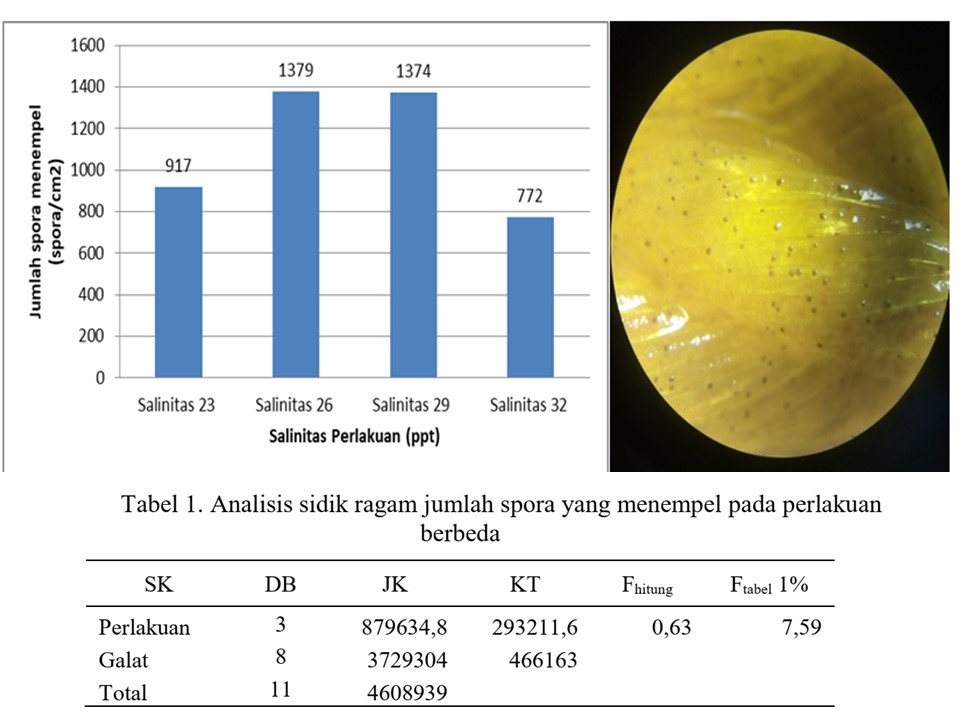Spora Growth Gracillaria sp in Different Salinities
DOI:
https://doi.org/10.46252/jsai-fpik-unipa.2019.Vol.3.No.2.71Keywords:
Gracillaria sp, spore growth, salinityAbstract
The demand for Gracillaria commodities continues to increase for food, medicines, and beauty ingredients. These conditions encourage the cultivation of this commodity continues to proliferate. Because of that, availability of Gracillaria sp seeds is available both in quantity and quality. One effort that can be done in handling the Gracillaria sp spores through environmental engineering. One such factor is fisheries salinity. The difference in salinity supports the increase in Gracillaria spores so that it affects spore growth. The aim of the study was to study the growth of Gracillaria spores cultured on different salinity media. The method used is a laboratory experiment method with a completely randomized trial design (CRD) with forty salinity preparations (23 ppt, 26 ppt, 29 ppt, and 32 ppt) and is repeated three times. The resulting data were then analyzed by analysis of variance. The results showed the highest spore growth at 23 ppt salinity with the number of spores (560.9 Ind / cm2), then 26 ppt salinity (438.8 Ind / cm2), then 32 ppt salinity (429.9 Ind / cm2) and low in salinity 29 with the number of spores (277.8 Ind / cm2). Fingerprint analysis showed that each evaluation results were not significantly different.
Downloads
References
Choi, H. G., Kim, Y. S., Kim, J. H., Lee, S. J., Park, E. J., Ryu, J., & Nam, K. W. (2006). Effects of temperature and salinity on the growth of Gracilaria verrucosa and G. chorda, with the potential for mariculture in Korea. Journal of Applied Phycology, 18(3–5), 269–277. https://doi.org/10.1007/s10811-006-9033-y
Kadi, A. (2004). sumber: www.oseano grafi.lipi.go.id. XXIX(4), 25–36.
Kanjana, K., Radtanatip, T., & Asuvapongpatana, S. (2011). Fish & Shell fi sh Immunology Solvent extracts of the red seaweed Gracilaria fi sheri prevent Vibrio harveyi infections in the black tiger shrimp Penaeus monodon. Fish and Shellfish Immunology, 30(1), 389–396. https://doi.org/10.1016/j.fsi. 2010.11.016
Kim, J. K., & Yarish, C. (2014). Development of a sustainable land-based Gracilaria cultivation system. Algae, 29(3), 217–225. https://doi.org/10.4490/algae.2014.29.3.217
Kim, J. K., Yarish, C., Hwang, E. K., Park, M., & Kim, Y. (2017). Seaweed aquaculture: Cultivation technologies, challenges and its ecosystem services. Algae, 32(1), 1–13. https://doi.org/10.4490/algae. 2017.32.3.3
Lideman, L., Elman, A., Kasturi, K., & Aldi, A. (2016). Petunjuk Teknis Produksi Bibit Gracilaria Laut (Gracilaria sp.) Melalui Kultur Spora Pada Tali.
Rahim, T., Tuiyo, R., & Hasim, H. (2015). Pengaruh Salinitas Berbeda terhadap Pertumbuhan dan Tingkat Kelangsungan Hidup Benih Ikan Nila Merah ( Oreochromis Niloticus ) di Balai Benih Ikan Kota Gorontalo. 3, 39–43.
Salim, Z., & Ernawati. (2015). Info Komoditi Rumput Laut. In 2013. Retrieved from https://www. scribd.com/document/400369283/Isi-BRIK-Rumput-Laut Satriani GK, Meidie A, Handayani S, S. E. (2017). Budidaya Rumput Laut Gracilaria verrucosa Secara In Vitro. 10(1), 37–45.
Sjafrie, N. (1990). Beberapa Catatan Mengenai Rumput Laut Gracilaria. XV(4), 147–155.
Suryono, C. (2012). Kejut Lingkungan Sebagai Upaya Percepatan Pelepasan Spora Rumput Laut Gracilaria gigas. Buletin Oseanografi Marina Oktober 2012. Vol. 1, 1, 10–14. Retrieved from https://docplayer.info/37902642-Kejut-lingkungan-sebagai-upaya-percepatan-pelepasan-spora-rumput-laut-gracilaria-gigas.html
Thanigaivel, S., Chandrasekaran, N., Mukherjee, A., & Thomas, J. (2019). Comparative Biochemistry and Physiology , Part C Protective e ffi cacy of microencapsulated seaweed extracts for preventing Aeromonas infections in Oreo-chromis mossambicus ☆. Compa-rative Biochemistry and Physio-logy, Part C, 218(December 2018), 36–45. https://doi.org/10.1016/ j.cbpc .2018.12.011
Valderrama Diego, Cai Junning, H. N. (Ed.). (2013). Social and economic dimensions of carrageenan seaweed farming. 2013.
Wu, H., Shin, S. K., Jang, S., Yarish, C., & Kim, J. K. (2018). hypo- and hyper-osmotic conditions. 33(4), 329–340.
Yudiati, E., Susilo, E., & Suryono, C. (2004). Teknik Setting Spora Gracilaria gigas Sebagai Penyedia Benih Unggul dalam Budidaya Rumput Laut. 37–40.



















